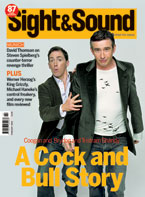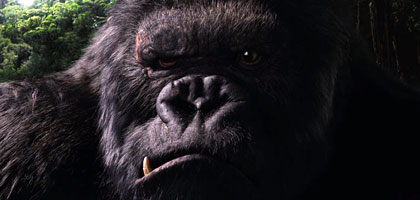Primary navigation

USA/Germany/New Zealand 2005

Reviewed by Kim Newman
Our synopses give away the plot in full, including surprise twists.
New York, 1933. Unemployed vaudevillian Ann Darrow is discovered by film producer Carl Denham, who needs to replace a leading lady on his troubled movie. Learning that the screenplay is by Jack Driscoll, whose plays she admires, Ann signs up. Denham ships out on the Venture, a tramp steamer, leaving dock ahead of the studio executives who want to shut down his project. Denham has a map of Skull Island, an unexplored land of mystery. After a frightening encounter with the island's inhabitants, the Venture's captain Englehorn insists on leaving the island, but the natives have abducted Ann. Jack rallies a rescue party, with Denham taking his camera in the hope of getting spectacular footage.
Ann is offered as a sacrifice to Kong, a giant gorilla who lives in a primeval jungle beyond a vast wall. Kong is dazzled by the blonde entertainer, and protects her from hungry dinosaurs after she tries to escape from him. While tracking Kong, the rescue party is caught in a dinosaur stampede; Kong kills one of them and shakes the others into a gorge, where they are attacked by giant insects. Jack takes off alone to rescue Ann, and Denham sets a trap for Kong. Jack helps Ann get away, but she is upset when she realises Denham's plans. Kong is trapped and chloroformed.
Some time later, Denham exhibits Kong on Broadway as "the eighth wonder of the world". Jack turns up on opening night to make sure Ann, who is scheduled to appear in the show, is safe; she has refused to participate and is working as a chorus girl instead. Kong breaks his chains and rampages through New York. Ann leaves the theatre where she's working and reunites with Kong, who has picked up and thrown away several other women while searching for her. The army shell the beast, who climbs the Empire State Building with Ann in his grip. The pair are strafed by biplanes. Kong protects Ann, but falls to his death.
Having beaten the odds and delivered a film adaptation of J.R.R. Tolkien's Lord of the Rings that managed huge commercial and critical success without alienating the book's legion of admirers, Peter Jackson has taken on an bigger challenge in remaking his favourite film King Kong. If not quite sacrosanct (Dino De Laurentiis bankrolled a famously dubious remake in 1976), King Kong, is near perfect in and of itself. No matter how enjoyable or gargantuan this new version might be, it's still in danger of landing on the same shelf as Gus Van Sant's Psycho, Jim McBride's Breathless and Alfonso Arau's The Magnificent Ambersons.
For all its hideous mistakes, the 1976 King Kong was a radical reworking of the material, to the extent of having Kong fall not from the Empire State Building but the World Trade Center. Jackson's version is more like a cover version, inserting slight variances on the original's character interplay (this Ann won't take part in Kong's humiliation on Broadway, whereas Fay Wray's had no such scruples) or whole new sub-plots almost in the spirit of fan fiction. Whereas the De Laurentiis version was updated to the 1970s, replacing the original's film-business backdrop with modish references to an ecologically rapacious oil industry, this goes back to the year of the original's creation. The opening, with Al Jolson's chillingly apt but ironic 'I'm Sitting on Top of the World' playing on the soundtrack, is a montage of New York in the Depression - breadlines, soup kitchens, novelty acts, starving zoo animals. There then follows some new-minted backstory about vaudevillian Ann Darrow and moviemaker Carl Denham, before the simple hooks of the first film (a starving Ann trying to filch an apple; the line "is this the moving-picture ship?") are deployed and we're again on that well-remembered voyage to adventure and Skull Island (which Jackson previously visited in Braindead, 1992).
Before embarking on the Rings films, Jackson got well into pre-production on an earlier draft of this script - which took a more knockabout comic approach, much like the tone taken by Stephen Sommers in his insufferable Mummy movies. Coming off the Rings trilogy as an A-list player, he has rethought the material and delivered a King Kong on the scale of a Titanic. Indeed, the Empire State Building climax is staged as a sort of parody of James Cameron's film, with the self-sacrificing Kong in the Leonardo DiCaprio role and Naomi Watts' Ann shoved protesting onto a safe perch as Kate Winslet (mooted star of Jackson's earlier, aborted King Kong).
Recognising that 2005 is not 1933, Jackson also incorporates moments that almost satirise Merian C. Cooper and Ernest B. Schoedsack's original: a gruff shipboard dialogue scene taken from the 1933 film's script is restaged as a hokey sequence in Denham's movie; and the now unacceptable back-lot exotica of the original sacrifice scene is recreated as a crass, inauthentic ooga-booga act on Broadway. Jackson's own versions of the Skull Island scenes are no less fantastical than those of Cooper and Schoedsack, but are inevitably more technically up to the minute: the islanders are not the black African caricatures of 1933, but nightmare figures out of a cannibal-themed video nasty; their attacks are staged in primal, frightening strokes, with blurry inserts, driving rain and a great deal of screaming.
Once in the lost world, Jackson reproduces the breathless pacing of the 1933 film, tipping from one huge set-piece to the next: a stampede of lumbering vegetarian behemoths harried by raptor-like carnivores mixes up with fleeing sailors as if they were doing the bull run at Pamplona; Kong's fight with a tyrannosaur is an instant classic action sequence in which the big ape beats off three giant lizards and Ann swings towards the jaws of a dinosaur trussed in hanging lianas; an attack by a variety of truly hideous, over-large insects (the equivalent scene was deleted from Schoedsack and Cooper's film because it, as now, took the action from Kong); and Jack's sterling rescue of Ann as Nosferatu-style bat creatures harry Kong. In New York, things hardly slow down. Kong's rampage inside the theatre is great stuff, but Jackson appropriately saves his best shots for a last stand that homages and expands the 1933 finale with dizzying views from every possible perspective. Oddly, it was De Laurentiis who best expressed why King Kong's finale works: "No one cry when Jaws die." Here, the heartstrings are shamelessly tugged, and every audience in the world is bound to respond with misty eyes as the biplanes buzz the gorilla.
It is admirable that, unlike most other Kong resurrections and homages (starting with 1933's The Son of Kong) Jackson's film doesn't tidy away all of the gorilla's monstrousness: a brute who has been dismembering sacrifices for years, the new Kong casually murders a sympathetic sailor (though cabin boy Jamie Bell's vengeance crusade is a plot-line that goes nowhere) and is given to tossing away substitute blondes with such ferocity that he qualifies as a serial killer. However, the most significant alteration to his character is that he seems less like a hormonal teenager than a big, battered baby: an innocent who treats Ann as a toy (cuddling her in a delightful, if curtailed slidearound on the ice in Central Park), a best pal (sulking when she tries to be grateful to him for saving her life after an early escape attempt) and almost a substitute mother (we see the skeletons of his real family, thus emphasising that he is the last of his race). In 1933, Kong's interest in Ann was explicitly sexual; omitted here is the moment when he peels away Ann's dress and sniffs the female smell on the garment. Watts' Ann is given to Kong for reasons unknown, and no one ever makes explicit her sacrificial status as a "bride of Kong". Purifying the ape's devotion arguably enhances the romanticism, and unquestionably avoids the original's undertones of bestiality (not to mention racism), but it's the sexual drive that differentiates King Kong from Schoedsack and Cooper's Mighty Joe Young (1949, already remade) and almost every other giant-monster movie. Changing that angle makes this seem a more timid, less primal version of the tale. Jackson's film is liable to please Kong's fans in the way Roland Emmerich's Godzilla failed to appeal to the Japanese monster's core audience, but - despite admirable chest thumping and Watts' wonderfully enhanced scream - there is still only one true king.